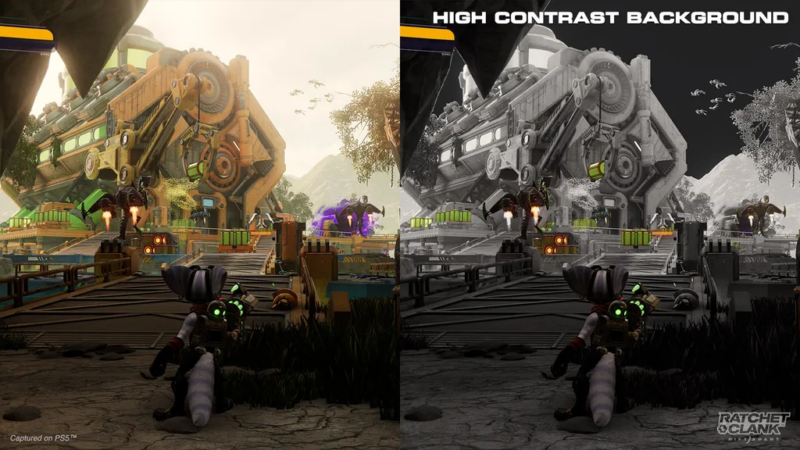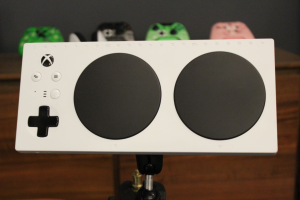Gaming is for everyone —
Hardware and software solutions open gaming to a wider audience than ever.
Meagan Shelley
–

Enlarge / The high-contrast backgrounds in Ratchet & Clank: Rift Apart are just one of the more prominent examples of game designs tuned for the visually impaired.
According to a recent study, more than 2 percent of the US population can’t play video games due to poor accessibility options. This same study suggests more than 9 percent are unable to enjoy the traditional gaming experience because of visual, cognitive, or physical impairments. Additional research suggests 20 percent of the casual gaming audience is disabled in some fashion.
That amounts to millions of disabled players who are locked out of games because of a lack of support. But after decades in which accessibility options were absent or an afterthought, game developers in recent years have shown an increasing willingness to cater to this audience explicitly.
The Last of Us Part 2 launched in 2020 with a wide array of heightened accessibility options, for instance. Assassin’s Creed Valhalla offers multiple forms of eye-tracking support, as well as colorblind options for the visually impaired.
Last year’s mega-hit Hades provided buffing support when your character dies in an effort to match the game’s difficulty to the player’s skill level. More recently, Ratchet & Clank: Rift Apart made waves with accessibility options such as high-contrast backgrounds, shader categories, and speed settings for fans and beginners alike.
Many independent game producers are continuing to invest in the hardware, tech, and tools necessary to bring gaming to a patiently waiting audience. Indie maven Aaron Fothergill, the co-founder of UK’s Strange Flavour studio harnesses the power of gyro/camera controls and AR systems to assist the mobility impaired in his flagship game AiRburst. “This would also potentially make it playable from a wheelchair for someone with limited dexterity but the ability to rotate their chair,” Fothergill said in an interview.
These are just a few prominent examples of a trend that’s bubbling up across all corners of the game industry.
Setting the standards
According to researchers at Universal Access in the Information Society, accessibility options in games should overcome three primary barriers: sensory-impaired feedback, motor impairments, and cognitive delays. In order for a game to be truly accessible, it should meet or exceed standards in each of these categories. The number of development tools focused on providing these considerations is quickly growing, as evidenced by the Library of Congress’ accessibility research and developments page.
Not every video game-maker takes all three factors into account, though. Some studios prefer to follow the bare-minimum guidelines, such as adding subtitles and other easy-to-implement features. Others go above and beyond, such as 2018’s Celeste or 2020’s HyperDot, winner of the Innovation in Accessibility Award.
Accessible games encompassing a wide variety of needs assist more than just disabled players, too. “Accessibility helps everyone,” says Diane Landais, co-founder and programmer at indie studio Accidental Queens, in a Pocket Gamer interview. “Thinking about accessibility doesn’t only mean catering to an audience with a given set of disabilities or specific needs; it’s about making sure the experience you want to create can be enjoyed equally by as many people as possible in as many situations as possible.”
Accessibility is particularly important for indie developers like Nathan Fouts, founder of Mommy’s Best Games. One-switch or mouth-powered inputs are important for games like Shoot 1UP, which adds a twist to a familiar shoot-’em-up genre. According to Fouts, accessibility options should include “remappable controls, subtitles, high-contrast backgrounds, colour-blind icons and symbols, gameplay speed adjustments and of course difficulty adjustments.” These are evident in other games produced by the studio, including Pig Eat Ball, a top-down action-adventure.
Hardware solutions
Software-specific considerations—as in the examples cited above—may be difficult or costly to implement for small or independent development teams. But generalized hardware accessories, including handheld tools and single inputs, can make an enormous impact on the player base without the need for explicit software support. Hardware and software working together can provide the greatest amount of compatibility for the greatest number of players.
The Microsoft Adaptive Controller is easily the most prominent example of adaptive controls. With 19 different 3.5 mm jacks, it can be mounted for players who cannot hold or manipulate standard controllers. Dozens of different add-on attachments can be plugged into the jacks, making it a well-rounded tool for many kinds of disabilities.

Enlarge / The Microsoft Adaptive Controller is easily the most prominent example of adaptive controls.
Broadened Horizons, an assistive technology company that specializes in gaming, offers disability controls for those requiring hands-free inputs as well as adaptive handhelds that meet accessibility needs in a variety of games and genres. According to its site, two-step adaptive controls (one button and one joystick) provides access to 100 percent of games on every console ever made.
Tools like the Racing Auditory Display (RAD) can help blind or visually impaired players navigate racing games and flight simulators. By timing auditory tones with oncoming obstacles, players can complete driving or flying games without much difficulty.
New developments in “puff and sip” inputs are changing the ways people play indie games. Also called “adaptive switches,” these tools allow players to provide two separate inputs for different types of consoles. “Puffing” (blowing air into the tube) and “sipping” (breathing air from the tube) allow for the hands-free input of commands.
The future of accessibility may not be altogether clear, but passionate accessibility activists are working long days and nights to bring the world of gaming to diverse individuals. It’s their hope, and ours, that the accessibility revolution will one day become the status quo. In time, studios large and small may be opting for a more enjoyable, open, and inclusive gaming future.

